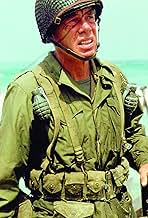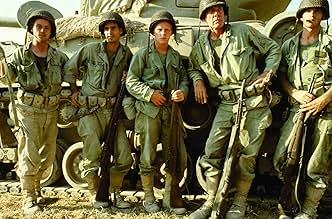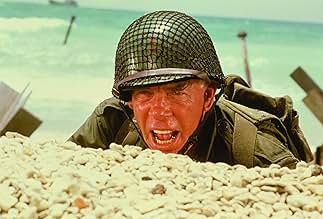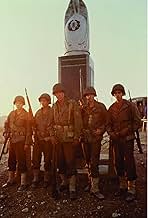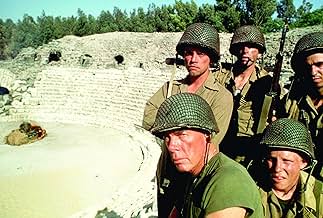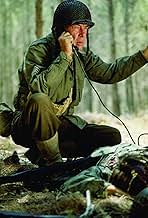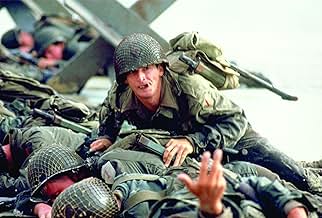VALUTAZIONE IMDb
7,1/10
22.380
LA TUA VALUTAZIONE
Un sergente veterano e i quattro membri principali della sua unità di fanteria cercano di sopravvivere alla seconda guerra mondiale mentre si spostano di battaglia in battaglia attraverso l'... Leggi tuttoUn sergente veterano e i quattro membri principali della sua unità di fanteria cercano di sopravvivere alla seconda guerra mondiale mentre si spostano di battaglia in battaglia attraverso l'Europa.Un sergente veterano e i quattro membri principali della sua unità di fanteria cercano di sopravvivere alla seconda guerra mondiale mentre si spostano di battaglia in battaglia attraverso l'Europa.
- Regia
- Sceneggiatura
- Star
- Premi
- 2 vittorie e 2 candidature totali
Stéphane Audran
- Underground Walloon Fighter at Asylum
- (as Stephane Audran)
Recensioni in evidenza
Some movies are like buried treasure; someone manages to slip them into the theater, practically under every critic's nose, where they either thrive or famish and then vanish into the nearest video catalog. "The Big Red One" is one of those films. For all the hoopla created by "Saving Private Ryan" (another excellent film, which, in my opinion, had a better understanding of it's subject than a lot of it's critics gave it credit for), it owed a great deal to what Sam Fuller did a decade and a half before.
Lee Marvin, an actual WWII veteran himself, holds the film together as the tough but exhausted seargent. When he tells Mark Hamill (yes, Luke Skywalker, folks) that you don't murder animals, you kill them, the look on his face after that seems to say that he wished it could be some other way. It's hard to grab defining moments in this film as stand-out, but the two sequences that stick the most to my mind are the taking of the insane asylum and the horrors of the concentration camp. While other movies have focused on specific campaigns, "The Big Red One" deserves high marks for painting the broad canvass of the Second World War from the perspective of the guys who actually had to do the work.
Lee Marvin, an actual WWII veteran himself, holds the film together as the tough but exhausted seargent. When he tells Mark Hamill (yes, Luke Skywalker, folks) that you don't murder animals, you kill them, the look on his face after that seems to say that he wished it could be some other way. It's hard to grab defining moments in this film as stand-out, but the two sequences that stick the most to my mind are the taking of the insane asylum and the horrors of the concentration camp. While other movies have focused on specific campaigns, "The Big Red One" deserves high marks for painting the broad canvass of the Second World War from the perspective of the guys who actually had to do the work.
Perhaps I am an exception but this film really did nothing for me.
The premise is simple: the experiences of a US infantry squad led by Lee Marvin fighting in Europe and North Africa during WW II. It was supposed to be about the experiences of the men who fought but I didn't feel the film delivered that: none of the characters were really explored or given much depth, even the great Lee Marvin seemed distant and cold. There isn't too much dialogue, in fact there isn't too much of anything in this film. Its just there but it doesn't really give you much, it just leaves you cold. The plot is occasionally just plain weird and confusing, not the good kind of quirky type of weird but just strange for no apparent reason and with no charm to it.
The action scenes are average, nothing special but enough for their purpose. What annoyed me was that so many different locations were so obviously filmed in the same sandy country (Israel) and it just didn't come off as very convincing. I didn't believe that what I was being shown was really the place it was supposed to be. Its also a quiet film, with very minimal music which in itself isn't bad but just gave the whole thing a somewhat sleepy atmosphere. I wouldn't go so far as to say the film was boring, it wasn't but it just wasn't that attention grabbing either.
Its a film that is there but it did absolutely nothing for me. Others however might enjoy it.
The premise is simple: the experiences of a US infantry squad led by Lee Marvin fighting in Europe and North Africa during WW II. It was supposed to be about the experiences of the men who fought but I didn't feel the film delivered that: none of the characters were really explored or given much depth, even the great Lee Marvin seemed distant and cold. There isn't too much dialogue, in fact there isn't too much of anything in this film. Its just there but it doesn't really give you much, it just leaves you cold. The plot is occasionally just plain weird and confusing, not the good kind of quirky type of weird but just strange for no apparent reason and with no charm to it.
The action scenes are average, nothing special but enough for their purpose. What annoyed me was that so many different locations were so obviously filmed in the same sandy country (Israel) and it just didn't come off as very convincing. I didn't believe that what I was being shown was really the place it was supposed to be. Its also a quiet film, with very minimal music which in itself isn't bad but just gave the whole thing a somewhat sleepy atmosphere. I wouldn't go so far as to say the film was boring, it wasn't but it just wasn't that attention grabbing either.
Its a film that is there but it did absolutely nothing for me. Others however might enjoy it.
This film is really about the experiences that Sam Fuller had during WWII. It is a bit dated, and the low budget really shows, but SF clearly did the best with what he had, and it stands as a great monument on war from a director who was really there.
All of the characters are very likeable, and well acted by Lee Marvin, Mark Hamill, Robert Carradine, and company. The movie is fiction but influenced by real events. Many of the scenes, especially one involving a group of older sicilian women who cook a big meal for the squad, ring very true, since a fiction writer would obviously try and spice them up--the film is very honest, and it is good that Fuller left this story for us. I also like how it ends on a positive, optimistic note.
"The real glory of war is surviving."
All of the characters are very likeable, and well acted by Lee Marvin, Mark Hamill, Robert Carradine, and company. The movie is fiction but influenced by real events. Many of the scenes, especially one involving a group of older sicilian women who cook a big meal for the squad, ring very true, since a fiction writer would obviously try and spice them up--the film is very honest, and it is good that Fuller left this story for us. I also like how it ends on a positive, optimistic note.
"The real glory of war is surviving."
"The Big Red One" is an episodic war movie from maverick American filmmaker Samuel Fuller. Having only seen "Shock Corridor" from the director's oeuvre, I didn't know what to expect from him this time around. It becomes obvious pretty quickly that Fuller was never going to be a mainstream filmmaker. There's something about his style that's really off-putting. You empathise with the camera, not the actors. It's like they're at odds with each other.
This is not a bad thing, as you can tell from the enthusiastic reception Fuller's movies have gotten here on IMDB. But "The Big Red One" is also drastically cut down from the original print Fuller had, and I wonder if that's why it feels so disjointed.
Of course, it is supposed to be episodic, but I don't know. I didn't really get into it.
This is not a bad thing, as you can tell from the enthusiastic reception Fuller's movies have gotten here on IMDB. But "The Big Red One" is also drastically cut down from the original print Fuller had, and I wonder if that's why it feels so disjointed.
Of course, it is supposed to be episodic, but I don't know. I didn't really get into it.
I have seen this film quite a few times and have always been somewhat puzzled about it. There was no doubt that it had some of the most emotive scenes of any war film but seemed fractured. At times there seemed to be far more realism in it's morality than other films which was understandable since Sam Fuller actually served with The Big Red One at this time so much of it is a first hand account of events and attitudes. I have now read some of the background to the making of the film,I think in the L.A. Times,which now makes sense of the flaws in the film. Apparently Sam Fuller's budget was cut to the minimum by the studios after a regime change and the original screenplay as shot was hacked to death by the same studio against Fuller's wishes. This was not the film he wanted to make but he made it. And it was not the film that he shot as is indicated by the very complete screenplay notes he made. I think it is Richard Schickel, the noted reviewer of Time magazine, who has laboured to find the missing outtakes and to put the film together in its complete form with over 40 minutes added to the length. Apparently this more complete cut significantly improves the film and adheres to Sam Fullers screenplay more accurately. This new cut is now playing to limited audiences and, hopefully, will be available on DVD. It must be emphasized that this is not the film that Fuller originally wanted to make as the budget was cut by 75%. Some of the comments made by other reviewers on these pages are valid as to authenticity specifically in battle scenes. But Fuller did not have the budget that both the Longest Day and Saving Private Ryan had. It will be interesting to see the new cut. Hopefully it will flesh out what could have been one of the greatest Second World War films.
Lo sapevi?
- QuizThe bulk of the picture was shot in Israel, and director Samuel Fuller remarked that it was unsettling after a scene was shot when the German soldiers and SS troops would take off their helmets and Fuller would see them wearing yarmulkes; also, between takes they would be sitting around the set in full Nazi uniform speaking Hebrew or reading the Torah.
- BlooperDuring the WW1 scene between the Sergeant and the officer in the dug-out, the Sergeant learns that the armistice had been signed 4 hours previously at 1100hrs, November 11, 1918. While talking with the officer, the sergeant is cutting a piece of red cloth in the shape of a number '1' which he says he will submit as a proposed insignia for the division. However the shoulder sleeve insignia for the 1st Division consisting of a red number "1" was already approved on 31 Oct 1918.
- Citazioni
Johnson: [concerning a woman in labor] How do you say "push" in French?
The Sergeant: Poussez.
Johnson: [to woman] Pussy! Pussy! Pussy!
- Versioni alternativeIn 2004, film critic Richard Schickel restored this film to a new director's cut length of approximately 160 minutes. Using Samuel Fuller's production notes and the full-length, unexpurgated script, Schickel restored the footage that was forced to be cut by the studio upon its original 1980 release (which runs 116 minutes). The restored version's DVD release date is 3 May 2005. This longer, epic-length version is closer to Fuller's original vision for the film.
- ConnessioniFeatured in A tout coeur: Episodio datato 7 maggio 1984 (1984)
- Colonne sonoreHorst-Wessel-Lied
Written by Horst Wessel
I più visti
Accedi per valutare e creare un elenco di titoli salvati per ottenere consigli personalizzati
Dettagli
- Data di uscita
- Paese di origine
- Lingue
- Celebre anche come
- Más allá de la gloria
- Luoghi delle riprese
- Aziende produttrici
- Vedi altri crediti dell’azienda su IMDbPro
Botteghino
- Budget
- 4.500.000 USD (previsto)
- Lordo Stati Uniti e Canada
- 7.206.220 USD
- Lordo in tutto il mondo
- 7.206.823 USD
- Tempo di esecuzione
- 1h 53min(113 min)
- Colore
- Mix di suoni
- Dolby Stereo(original release)
- Proporzioni
- 1.85 : 1
Contribuisci a questa pagina
Suggerisci una modifica o aggiungi i contenuti mancanti


